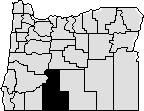
Klamath County was established on Oct. 17, 1882. It was created from the western part of Lake County and named after a tribe of Indians that white travelers called the Klamath, also spelled Clammite.
Klamath County is in south central Oregon. The county is bounded on the south by California, on the east by Lake County, on the north by Deschutes County, and on the west by Jackson and Douglas Counties. The county, Oregon's fourth largest, has 6,135 square miles.
When the Legislative Assembly created Klamath County in 1882, it designated Linkville as the county seat, although it gave the voters the chance to select another site at the 1884 general election. Linkville was renamed Klamath Falls in 1893.
In 1888 the county acquired its first courthouse for $3,500. Previously a school or rented commercial premises housed county offices. By 1912 the need for a new courthouse was pressing. However, for the next 13 years a dispute raged over its location and which of the two courthouses being built would be accepted. The first courthouse, known as the Hot Springs Courthouse, was designed along Grecian architectural lines, but, due to law suits and recall elections, only the exterior was finished. When construction stopped, $112,000 had been spent, with an additional $60,000 needed to complete the project. It was torn down in 1927 to make way for the Klamath Union High School.
In 1918 construction began on another courthouse, known as the Main Street Courthouse which was built next to the existing one. In spite of injunctions to halt construction, the work was completed within a year, but the building was not fully occupied until 1923, when all legal questions were settled. The structure cost about $122,000. Earthquakes in 1993 damaged the building, and county offices were relocated to temporary quarters. Construction of a new courthouse and administrative center began in 1997.
The government of Klamath County consisted originally of a county judge, two county commissioners, clerk, treasurer, coroner, surveyor, and sheriff. The judge's position was abolished in 1965, and the number of county commissioners increased from two to three.
The 1890 census cited a population of 2,444. Since then the county has experienced steady growth. The 2018 population of 67,960 represented a 2.4% increase from 2010.
Historically, Klamath County's economy has been based on timber and agriculture. Three-fourths of the county is forested; however, over half is publicly owned. The large stands of timber resulted in the development of wood products industries in the county. In spite of the high altitude, short growing season, low rainfall, and cold winters, agricultural plays an important role in the economy. Excellent soil, a network of irrigation, extensive sunshine, and the introduction of cash crops such as potatoes and feed barley have contributed to the agricultural industry. In recent years water rights issues have clouded the situation, with agricultural uses being challenged by tribal and environmental concerns. The many lakes and mountains, including Crater Lake National Park, attract tourists and recreational visitors to the county.
The Klamath Indian Tribe and Reservation add to the county's history. The Klamath Reservation was established in 1864 by treaty and covered about 50 square miles of land east and northeast of Klamath Falls. The federal government's policy of termination and assimilation resulted in the tribe being abolished in 1961. However, in 1975 a fully functioning tribal government was reestablished, and the Klamath Tribe was recognized by the federal government in 1986.